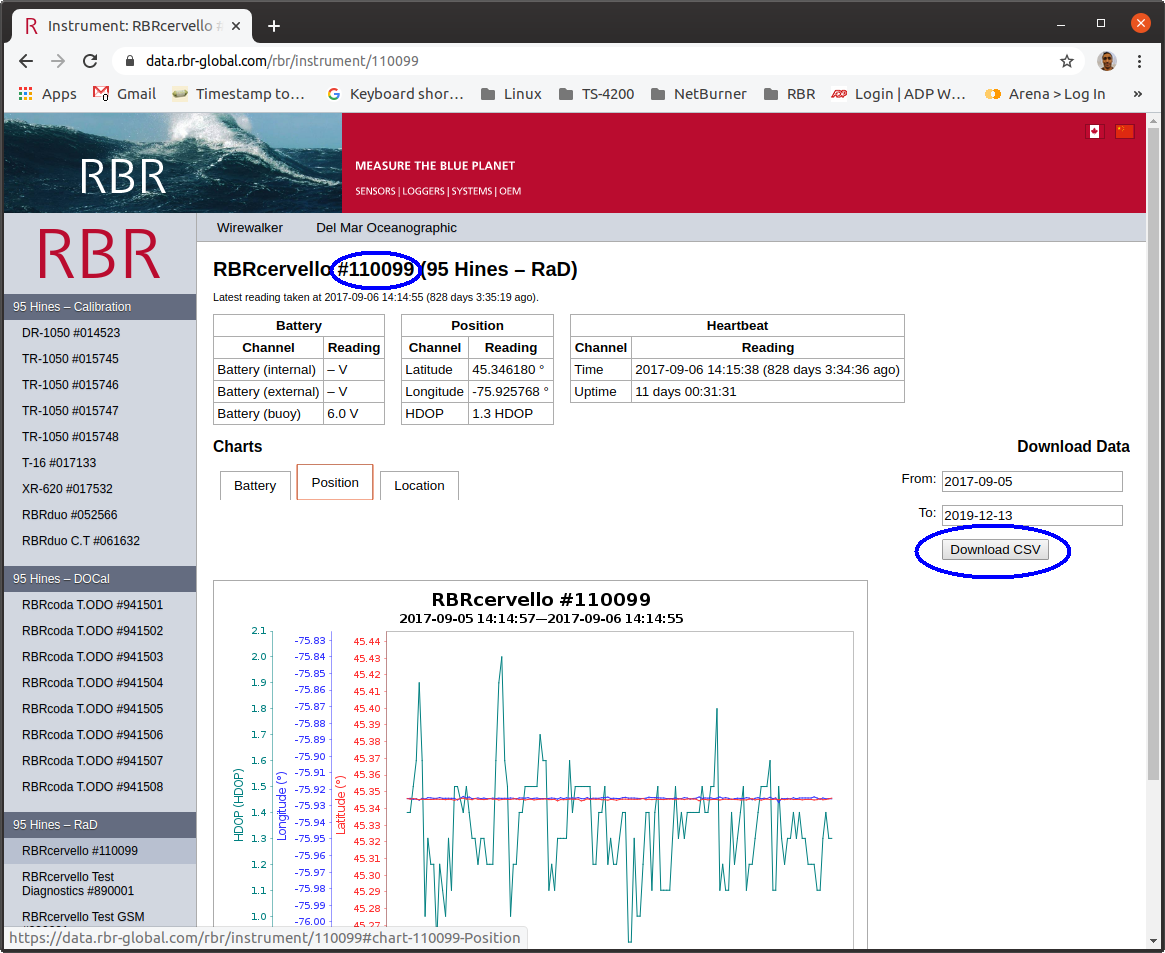Data hosting
The RBRcervello is optionally supplied with real-time telemetry in the form of GSM cellular and Iridium Satellite modems. These send data to the RBR data hosting service, which is accessible at https://data.rbr-global.com/ClientReference
. Each client site may be public or password protected. One year of data hosting service is included with each RBRcervello. After the first year, contact RBR to purchase additional years of service.
Your data is stored on the RBR data-hosting portal in the form of comma-separated value (CSV) files.
Data controllers report data under two different serial numbers: one for the attached instrument (RBRconcerto3 or RBRmaestro3 ), and one for diagnostic information (battery levels and GPS coordinates). Remember to download from the appropriate instrument.
Obtaining data from the RBR data-hosting portal
Navigate to https://data.rbr-global.com/rbr (replacing RBR with your customer name) and click "Download CSV".

Obtaining data using a shell script
Use the getcsvdata.sh script to poll and download data for a particular instrument.
After downloading the script, you will have to change the file permissions to enable execution. For example, to permit all users on the system to execute the script:
Set script permission
chmod +x getcsvdata.shCall the script using your customer URL slug, serial number, start date, and end date as arguments. For example, to download all data for the RBR's device "110099" from September 1, 2017 to December 31, 2020, use the script with this command:
Get data example
./getcsvdata.sh rbr 110099 2017-09-01 2020-12-31Manually downloading data files
Retrieve exports of instrument data by making HTTP GET requests via this URL pattern:
https://data.rbr-global.com/customer/download/serial?from=A&to=B
or
https://data.rbr-global.com/customer/download/serial?timespan=C
-
customeris the customer slug; e.g.rbr,csiro -
serialis the serial number of the instrument for which data should be retrieved -
AandBare UTC dates in YYYY-MM-DD format and respect the instrument timezone. Alternatively, they can be YYYY-MM-DDTHH:MM:SS. -
Cis an integer number of days
-
The first format will yield a CSV of all data from dates A to B, inclusive of both. The second format will yield a CSV of all data from the last C × 24 hours (not the most recent C × 24 hours of data available!).
For example, use the above URL format within a "curl" command to obtain the data from RBR's instrument with serial number 080296 from September 8, 2016 to September 9, 2016:
Example of downloading using "curl"
curl --location --remote-name --remote-header-name --compressed 'http://data.rbr-global.com/rbr/download/080296?from=2016-09-08&to=2016-09-09'It can also be more granular, from September 8, 2016, at 10:00 to 20:00:
Example of downloading using "curl"
curl --location --remote-name --remote-header-name --compressed 'http://data.rbr-global.com/rbr/download/080296?from=2016-09-08T10:00:00&to=2016-09-08T20:00:00'Remember to enclose the URL in quotation marks, lest your shell split the command around the ampersand (&) character.
In general, restrict yourself to downloading around one or two days of data at a time, and later concatenating the results. An instrument sampling at 6Hz will generate almost 100MB of CSV data per day. Large transfers may time out during the download process or your connection may be unexpectedly dropped.
Low bandwidth transfers
If your computer has relatively low bandwidth, use the getcsvdata.sh script described above to acquire data and save them to a server with high bandwidth, always-on connection. Subsequently, transfer only the difference using the "rsync" command.
Use 'rsync' for data pull from low bandwidth remote computers
rsync --verbose --archive --partial --progress --compress myusername@my.server.address:/my/data/path/RBR-080296.csv .Downloads
